Exercises (2273)
Strength: trunk flexion and straight stroke
Light-Contact
Partner work



Participant A lies on their back with their legs bent and feet up. The shoulder blades are raised off the floor and the fists are doubled in front of the head (hands at chin height). Participant B stands upright at his partner's head height with bent forearms (90 degrees at the elbow joint). Participant A raises his upper body explosively, rotates his upper body slightly and strikes crosswise against the hand of participant B (strikes with the left and right fist alternately). The upper body is lowered between repetitions, but the shoulder blades do not touch the floor.
Variant:
Lift the upper body, perform 3 alternating punches (e.g. li-re-li) and lower the upper body again.
Per participant
1 pair of boxing gloves
Per group
1 soft mat (small)
Power: Types of impact
Light-Contact
Partner work


Two participants stand one behind the other in front of the raised (large) soft mat. For 10-15 seconds, the person in front boxes a predetermined punch or punch combination against the mat (really exhausting themselves). Once the time has elapsed, he makes room for his partner and lines up behind him. The second participant now begins to hit the mat. The sports director specifies the number of passes.
Participant:
1 pair of boxing gloves
Pro group:
1 soft mat (large)
Strength: Skipping rope
Light-Contact
Individual work
Skipping rope:
- bipedal
- jumping on one leg (left/right)
- right/left leg first (variation: lift leg/knee correctly or jump only lightly on the ball of the foot)
- alternating right/left leg first (variation: lift leg/knee correctly or jump only lightly on the ball of the foot)
- alternating left/right heel on the floor
1 skipping rope
Strength/duel: abduction and adduction of the legs in push-up position and push-up
Light-Contact
Partner work
In the push-up position, support your arms with your hands on an inverted long bench and place your legs on the floor. Spread your legs apart in small jumps and bring them back together in the starting position. However, a push-up (bending and stretching the arms) is also integrated into the exercise in the position with the legs apart before the legs are brought together.
Variant:
Vary the position of the hands/arms (e.g. wide, narrow, together).
Duelling:
After the strengthening exercise, a light contact fight takes place on the wide or narrow side of the inverted long bench.
Per group of 2:
1 long bench
Participant:
1 pair of boxing gloves
Strength/duel: alternating raising and lowering of one leg in forearm support
Light-Contact
Partner work
In the forearm support, the outstretched legs and upper body practically form a line. The legs are supported by the tips of the toes on an inverted long bench and the upper body is supported by the forearms on the floor. The forearms lie flat and parallel to each other with the upper arms resting vertically on the floor (90 degree angle at the elbow joint). Alternately, one leg is raised slightly (foot approximately at heel height).
Duelling:
After the strengthening exercise, a light contact fight takes place on the wide or narrow side of the inverted long bench.
Per group of 2:
1 long bench
Participant:
1 pair of boxing gloves
Strength/duel: Push-up
Light-Contact
Partner work
Push-up position, legs placed on the inverted long bench; bend and stretch arms (lower and raise upper body).
Variant:
Vary the position of the hands/arms (e.g.: wide, narrow, together).
Duelling:
After the strengthening exercise, a light contact fight takes place on the wide or narrow side of the inverted long bench.
Per group of 2:
1 long bench
Participant:
1 pair of boxing gloves
Strength/duel: push-up and jump over an object
Light-Contact
Partner work
From a standing position, bend your legs and place your hands next to your feet to get into a squat position. Support yourself with your hands and jump backwards with both legs to get into a push-up position. Bend your arms to fully lower your upper body (prone position). From the prone position, push back into the push-up position with both arms and jump back into the squat position. In the squat position, the upper body is slightly tilted forwards, stretch your arms backwards at an angle along your body (like a ski jumper on a ski jump), push off the floor powerfully to perform a jump (lateral-sided) over the long bench (use the momentum of the arms). Straighten the upper body and restart the exercise (assume a push-up position) to finally jump back to the starting position.
Variant:
Jump frontally over the long bench.
Duelling:
After the strengthening exercise, a light contact fight takes place on the wide or narrow side of the inverted long bench.
Per group of 2:
1 long bench
Participant:
1 pair of boxing gloves
Strength/duel: Jumping over an object from the side with the upper body supported
Light-Contact
Partner work
Support your upper body with your arms on the inverted long bench. Jump with both legs from one side of the long bench to the other.
Variant:
Land and jump with the outer leg only.
Duelling:
After the strengthening exercise, a light contact fight takes place on the wide or narrow side of the inverted long bench.
Per group of 2:
1 long bench
Participant:
1 pair of boxing gloves
Strength/duel: alternating jump on an object
Light-Contact
Partner work
Stand with one leg on the inverted long bench and the other leg on the floor. Alternate the foot position while jumping.
Duelling:
After the strengthening exercise, a light contact fight takes place on the wide or narrow side of the inverted long bench.
Per group of 2:
1 long bench
Participant:
1 pair of boxing gloves
Strength endurance test (KAT)
Examinations
Time ratios (25 min.) correspond to a group size of approx. 30 participants.
Of course, each participant is tested individually.
The strength endurance test (KAT) is used to test the conditional substance.
Execution regulations
Appendix:
The KAT must always be carried out indoors and cannot be moved outside. At the KAT, all posts are precisely prescribed and are located at a clearly defined location. A volleyball court should be marked out in the hall, as the controls are distributed from this court according to certain measurement specifications. The control posts are located within the volleyball court.
Post description:
Run: 4 painting sticks are required for the circuit.
Row: The poles are set at two different heights. Low spars 1.20 m and high spars 1.30 m. The distance between the bars is 60 cm.
Bench seats: The wide side of the bench faces upwards.
Push-up: A halved foam ball defines how low the upper body must be lowered (height 15 cm).
Torso bend: The wide side of the bench faces upwards. Optionally, fitness mats can be provided for the participants.
Execution:
Run: The run takes place around the entire volleyball court. Start in the corner behind the painting stick of the assigned partial volleyball court (1/3) by the parallel bars.
Row pull: The participant holds on to the bars in a heel position and in a strong back position (legs under the bars). The backs of the hands point towards the face (overhand grip). The upper body is raised and lowered by bending and stretching the arms (without losing the full body extension). The chest must touch the bars 12 times. Participants taller than 1.80 m choose the higher bar.
Bench sit: The participant sits on the long bench (one leg on each side). By jumping off with both legs, the participant reaches a standing position on the long bench. The participant jumps back to the starting position. The standing position on the bench must be reached 12 times (buttocks always touch the bench between jumps).
Push-up: The participant assumes the push-up position. The upper body is raised and lowered by bending and stretching the arms. The chest must touch the foam ball 12 times. Female participants assume the push-up position with their knees supported on the floor and feet held high.
Torso bend: The participant lies on their back. The legs are bent with the calves resting on the bench (heel not on the edge of the bench to support the movement). The participant must raise their upper body 12 times so that both hands touch the bench surface completely (wrist overhanging the front edge of the bench).
Female participants and male participants aged 41 and over must complete the strengthening exercises 10 times (instead of 12). Female participants aged 41 and over repeat the individual exercises 8 times (instead of 10).
The participant always has 2 minutes to complete the five exercises (= 1 round). The faster the exercises are completed, the more time is available for recovery (it is not possible to "run ahead"). The test leader gives the participant the start signal for the next round (every 2 minutes). The participant tries to complete as many rounds as possible.
A participant must stop the test if the required number of repetitions (12/10/8) is no longer achieved in an exercise; it takes more than 2 minutes to complete a round.
Attempts:
One.
Measurement:
Time: The participant has 2 minutes to complete a round.
Points: Each completed lap scores one point. The aim is to score as many points as possible. Half a point is awarded if the second strengthening exercise (bench sitting) is completed in full.
The participant counts the number of repetitions of the strengthening exercises independently. If more than one participant needs to be checked, the test leader will carry out spot checks. If a participant does not complete the correct number of repetitions, the test leader ends the test. If the test leader only checks one participant, he/she can count the number of repetitions out loud.
Control:
The test leader explains all the execution regulations to the participants in advance and demonstrates the exercises if necessary (however, all participants should be familiar with the test). During the strengthening exercises, the test leader stays with the participants and carries out spot checks on the number of repetitions of the individual exercises (ideally, one test leader checks one participant). The test leader sends the participants to a new round every 2 minutes. A test leader can control a maximum of 3 participants (a maximum of 9 participants per volley-ball field with 3 test leaders). As soon as a participant no longer achieves the required exercises within the 2 minutes, the test leader notes the completed rounds. Completed rounds result in half a point if the second strengthening exercise (bench sitting) is completed. The result is recorded directly electronically or transferred later from an evaluation sheet to an electronic device.
Evaluation:
Evaluation forms and electronic evaluation programmes are available for all sports tests:
www.armee.ch/sportausbildung
-> Downloads -> Sportprüfungen -> Auswertung -> KAT
For 3 participants and 1 test leader (9 participants and 3 test leaders):
1 (3) stopwatch(es), 4 (8) stakes, 1 (3) parallel bars, 2 (6) long benches, 3 (9) halved foam balls, 3 (9) fitness mats
Circular movement of the arms while standing upright
Power
Individual work
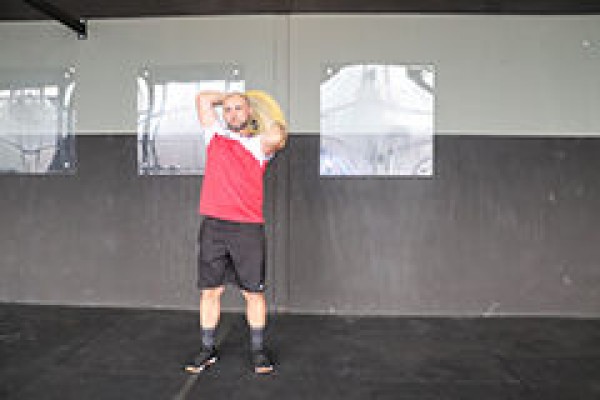



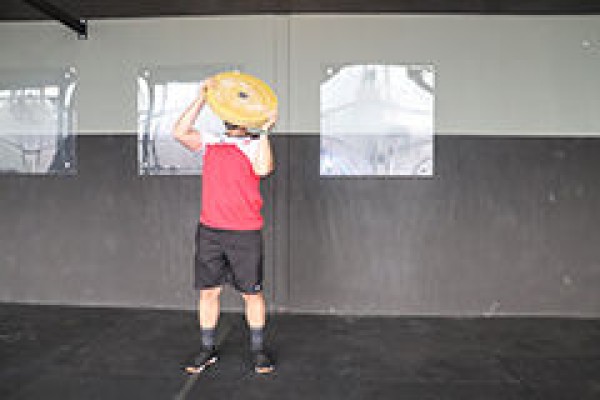

When standing upright, hold a weighted disc in front of your head with your arms bent and move the disc around your head with your arms bent, keeping the rest of your body stable except for your arms. The weight must be kept at head height throughout the exercise. Change the direction of rotation after one or more rounds.
Attention:
Upright posture.
Lighten:
Less weight.
Harden:
More weight.
1 weight disc
Circular movement of the arms in push-up position
Power
Individual work







Push-up position (high support, face/gaze downwards) with legs slightly straddling and arms supported on two small weight discs. Slide one arm including the disc forwards along the floor as an extension of the body, then move the outstretched arm to the side (90 degree angle to the body) and return to the starting position (the movement corresponds to drawing a quarter circle, so to speak). Back in the push-up position, perform the same exercise with the other arm/disc.
Attention:
Head, torso, hips and knees form a line (do not let your buttocks sag, tighten your stomach).
Lighten:
Just hold the basic position (push-up position); reduce the range of motion of the playing arm or only move it forwards and back to the starting position.
Harden:
Additional weight (on the back and/or arms).
2 weight discs (small)
1 weight vest/weight disc/sandbag ► Make the exercise more difficult (additional weight)
2 weight cuffs ► Make the exercise more difficult (additional weight)
Circular movement of the legs in supine position ► double leg circle
Power
Individual work



Lie on your back with your arms flat on the floor at your sides or place your hands under your buttocks and your outstretched legs slightly off the floor. Perform circular movements with your legs closed (vary the range of movement and direction).
Attention:
Keep your (lower) back in constant contact with the floor (no hollow back, consciously tense your stomach), do not put your legs down.
Lighten:
Just hold the position (legs stretched out slightly off the floor).
Harden:
Clamp additional weight for the legs/between the legs.
2 weight cuffs/1 (medicine) ball ► Make the exercise more difficult (additional weight)
Circular movements of the arms while standing (frontal) ► arm circles (frontal)
Power
Individual work
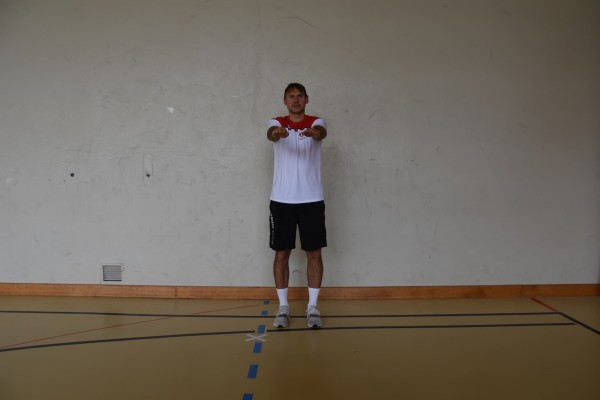
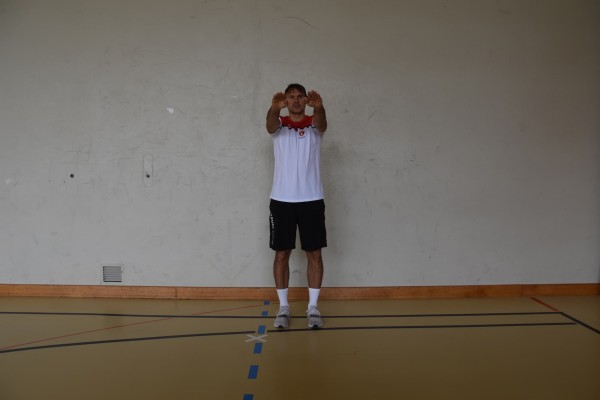
Stand upright with your feet shoulder-width apart, arms extended forwards (frontally) at shoulder height, perform small circles with your arms in both directions (shoulder height).
Attention:
Always keep your arms almost fully extended.
Lighten:
Stretch your arms less/bend them slightly.
Harden:
Hold additional weight on your arms or in your hands.
Variant:
Increase the range of motion (crown and navel height) and increase speed if necessary.
2 weight cuffs/weight balls/dumbbells ► Make the exercise more difficult (additional weight)
Circular movements of the arms while standing ► arm circles (lateral)
Power
Individual work
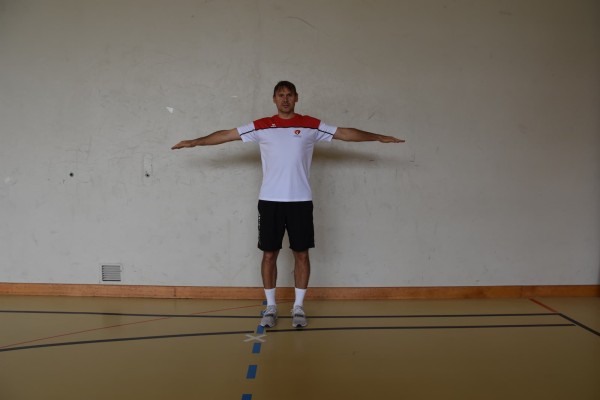
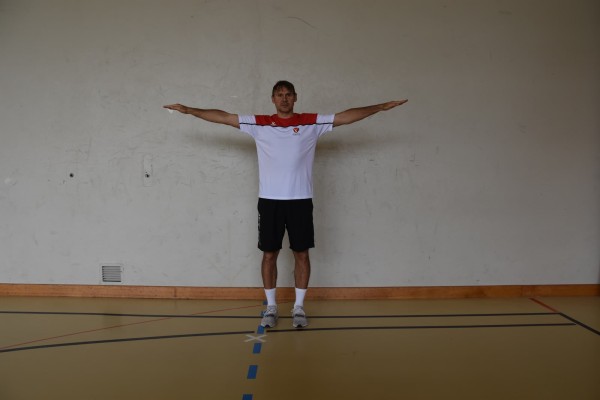
Stand upright with your feet shoulder-width apart, arms outstretched to the side at shoulder height, make small circles with your arms in both directions (shoulder height).
Attention:
Always keep your arms almost fully extended.
Lighten:
Stretch your arms less/bend them slightly.
Harden:
Hold additional weight on your arms or in your hands.
Variant:
Increase the range of motion (crown and navel height) and increase speed if necessary.
2 weight cuffs/weight balls/dumbbells ► Make the exercise more difficult (additional weight)
Lacrosse
Games / Tournament
Group work
Game idea:
Two teams with several field players and a goalkeeper play the ball with the intercrosse stick by skilfully attacking the opponent's goal. The aim is to prevent the opponent from scoring goals by playing good defence.
Scoring:
A goal is scored when the ball crosses the goal line completely.
Playing field:
45 m wide and 102 m long. The (floorball) goals are located 14m in front of the end of the pitch.
Number of participants:
10 against 10 (9 outfield players plus 1 goalkeeper), indoors 6 against 6.
Rules of the game:
After the referee's whistle, two players in the centre try to play out the ball between them, capture it or pass it to one of their teammates. The attacker/defender positions change as soon as the defending team has won the ball. Physical contact and knocking the ball away are permitted throughout the game.
Fouls: Personal fouls are pushing using the stick as resistance, blows with the stick that hit the body or head, unnecessary roughness. The penalty time for a personal foul is one to three minutes. Technical fouls include offside, pushing from behind, holding and the active use of the free arm of a player carrying the ball. Penalties for technical fouls are cancelled by a goal.
For safety reasons, however, the same rules as for intercrosse are also used outdoors in sports lessons, i.e. no physical contact is made.
Pull down the load in supine position ► lying behind the neck pull down
Power
Partner work
1 trainee & 1 helper ► Note change of position
(= double the time required; for lesson planner see Organisation Kraft: Info button Execution)


Exerciser: Lie on your back and hold the gymnastics pole above your head with your arms stretched out horizontally (arms parallel to the floor), legs slightly bent and heels up, pull the gymnastics pole into your neck against the resistance of the elasticated straps, raising your head slightly (looking towards the ceiling).
Partner: Hold the loops above the gymnastics pole on the floor.
Attention:
The lower part of the back (lumbar spine) remains on the floor throughout the exercise.
Lighten:
Select less strong elastic bands; roll up the elastic bands less or reduce the distance to your partner.
Harden:
Select stronger elastic bands, roll up the elastic bands more or increase the distance to your partner.
1 gymnastic stick with elasticated strap
Running ABC
Running training
Group work
6-10 participants per group (3-5 participants per side)
Depending on group size: start from both sides simultaneously or alternately.
The participants line up in groups opposite each other at a distance of approx. 15-20 metres. After completing the exercise, the participants line up again behind the opposite group.
The running ABC is a special form of coordination exercises and helps to improve running style. The easy-to-perform exercises promote mobility and muscular balance.
The running ABC should be familiarised with using various running exercises in smaller groups. It is advisable to keep the upper body, especially the head, upright during all exercises. The running ABC should be carried out with concentration and in a rested state. You should start with slow and technically clean movements. After a few repetitions, the speed of the steps can be increased.
Exercise selection (complete each exercise 2-4 times):
- Loose trotting forwards/backwards (perform a half turn in the middle, changing the direction of rotation with each run).
- Hop run
- Powerfully raise the knee of the swing leg, lift the thigh until it is horizontal;
- keep an upright posture, hips remain extended, eyes look straight ahead;
- the arms actively swing upwards (not forwards) and support the jump;
- roll over the entire foot;
- the hop run strengthens body extension and the footprint.
- Walking with a focus on rolling over the whole foot (arms swing along)
- Trotting with a focus on rolling over the whole foot
- Running dribbling (ankle work)
- Trotting with very small steps and high frequency;
- Knee alternately slightly upwards;
- the toe of the lifted leg points to the floor;
- active foot placement, starting on the forefoot, heel briefly touches the floor;
- Knee of the supporting leg remains extended;
- Arms are bent, the arm movement supports the leg movement;
- Hips move with
- Skipping
- Raise the knees alternately at a high frequency up to around 70 degrees;
- tighten the toes and only ever land on the forefoot;
- strong arm use;
- Variant:Insert an intermediate step after two skippings.
- Knee lift
- Bring your knees up to hip height;
- maintain an upright posture;
- Variant: Only lift your knees every third step.
- Lift off your heels
- Increased push-off from the ankle and calf;
- Bend the knee backwards to bring the heel towards the buttocks;
- Hips tilted slightly forwards;
- Arms swing along and support the running movement.
- Variant: Lift the knee only every third step.
- Lifting off your heels/knee lift
- Alternate 4 x heel lifts and 4 x knee lifts
- Alternate 4 x heel lifts and 4 x knee lifts
- Giant wheel
- Slow knee lift, once the knee is lifted, the lower leg is extended forwards and the foot is placed forwards in a circular motion.
- Slow knee lift, once the knee is lifted, the lower leg is extended forwards and the foot is placed forwards in a circular motion.
- Bouncing lunge
- Feet are parallel and in a line;
- one leg is pushed down hard;
- the other leg is bent at the hip;
- to land, bring the feet together again so that they touch the ground at the same time;
- immediately after landing, the other leg is pushed into the air.
- Jump run
- Powerful one-legged push-off (leg maximally extended);
- the other leg swings forwards (not upwards) à jump into the air;
- the arm movement is consciously active forwards and supports the jump;
- the thigh is horizontal in the flight phase.
- Side straddle run
- The body stands sideways to the running direction;
- spread the legs and bring them together again by jumping sideways;
- make sure your posture is upright;
- change direction.
- Crossover running
- The body stands sideways to the running direction;
- Cross your legs alternately in front of and behind your body;
- Turn only from the hips
- The arms are stretched out or resting on the hips;
- Improves hip mobility.
- Forward/backward running with incline running
- Running curves
Per group:
4 marking cones/caps
Running ABC (activation of the ankle)
Running training
Group work
6-10 people per group.
The exercise is completed with 2-4 repetitions over a distance of 10-15 metres.
If the weather and ground conditions allow, the exercise can also be performed without shoes.
Aim:
The aim is to activate good ground contact with the forefoot by trying to create a "springy" effect on the ankles ("active" foot) while keeping the legs stretched.
Focus:
The foot should remain parallel to the ground through dorsiflexion and be active when it touches the ground. The aim is to keep the heel as close to the ground as possible without touching the ground. The idea is for the feet to "hit" the ground as quickly as possible.
5 key points - running ABC
- The aim is to keep the foot "active" in dorsiflexion. Contact with the ground should not be made with the toe, but with the distal metatarsal area. This should achieve a "springy" effect in the area of the ankles. When landing with the toe or heel, the elastic energy of our muscles is dispersed, which is essential to increase running economy.
- The ground contact takes place just behind the vertical projection of the centre of gravity. The idea should be to bring the foot under the body to support it and not too far forward to avoid braking forces.
- Avoid remaining in a seated position during the exercises. When in contact with the ground, the hip joint should be almost fully extended, as should the knee joint.
- The arms are crucial for coordination. It is therefore important to use them actively and try to keep the shoulders relaxed so that they do not become stiff. The angle of the elbow joint should be around 90°. During the movement, the arms should be parallel to the body and not crossed in front.
- Throughout the exercise, the stability of the torso should be maintained by correctly activating the abdominal muscles. This prevents anteversion of the pelvis, which leads to a later running cycle. The shoulders should remain slightly in front of the body's centre of gravity.
No material required
Lauf-ABC (double switch)
Running training
Group work
6-10 people per group.
The exercise is completed with 2-4 repetitions over a distance of 10-15 metres.
If the weather and ground conditions allow, the exercise can also be performed without shoes.
Objective:
Starting from a one-legged stance with the knee at a 90° angle, reverse the leg position twice in succession as quickly as possible, returning to the starting position and trying to stop and maintain balance after each movement.
Focus:
The idea is to change as quickly as possible. To do this, it is important to remember to lower one leg as quickly as possible while lifting the other leg.
5 key points - running ABC
- The aim is to keep the foot "active" during dorsiflexion. Contact with the ground should not be made with the toe, but with the distal metatarsal area. This should achieve a "springy" effect in the area of the ankles. When landing with the toe or heel, the elastic energy of our muscles is dispersed, which is essential to increase running economy.
- The ground contact takes place just behind the vertical projection of the centre of gravity. The idea should be to bring the foot under the body to support it and not too far forward to avoid braking forces.
- Avoid remaining in a seated position during the exercises. When in contact with the floor, the hip joint should be almost fully extended, as should the knee joint.
- The arms are crucial for coordination. It is therefore important to use them actively and try to keep the shoulders relaxed so that they do not become stiff. The angle of the elbow joint should be around 90°. During the movement, the arms should be parallel to the body and not crossed in front.
- Throughout the exercise, the stability of the torso should be maintained by correctly activating the abdominal muscles. This prevents anteversion of the pelvis, which leads to a later running cycle. The shoulders should remain slightly in front of the body's centre of gravity.
No material required
Running ABC (dribbles one-legged)
Running training
Group work
6-10 people per group.
The exercise is completed with 2-4 repetitions over a distance of 10-15 metres.
If the weather and ground conditions allow, the exercise can also be performed without shoes.
Aim:
One leg remains extended with the "active" foot, the second leg takes alternating small steps. The foot should not be lifted more than 10-15cm.
Focus:
The idea is to make small circles with the foot of the free leg to simulate the cyclical movement of running.
5 key points - running ABC
- The aim is to keep the foot "active" during dorsiflexion. Contact with the ground should not be made with the toe, but with the distal metatarsal area. This should achieve a "springy" effect in the area of the ankles. When landing with the toe or heel, the elastic energy of our muscles is dispersed, which is essential to increase running economy.
- The ground contact takes place just behind the vertical projection of the centre of gravity. The idea should be to bring the foot under the body to support it and not too far forward to avoid braking forces.
- Avoid remaining in a seated position during the exercises. When in contact with the floor, the hip joint should be almost fully extended, as should the knee joint.
- The arms are crucial for coordination. It is therefore important to use them actively and try to keep the shoulders relaxed so that they do not become stiff. The angle of the elbow joint should be around 90°. During the movement, the arms should be parallel to the body and not crossed in front.
- Throughout the exercise, the stability of the torso should be maintained by correctly activating the abdominal muscles. This prevents anteversion of the pelvis, which leads to a later running cycle. The shoulders should remain slightly in front of the body's centre of gravity.
No material required
Lauf-ABC (dribbles)
Running training
Group work
6-10 people per group.
The exercise is completed with 2-4 repetitions over a distance of 10-15 metres.
If the weather and ground conditions allow, the exercise can also be performed without shoes.
Aim:
Take small running steps with the "active" foot and try to lift your feet a maximum of 10-15cm off the ground, keeping the movement as circular as possible.
Focus:
Imagine drawing circles with your feet as if you were riding a pedalo.
5 key points - running ABC
- The aim is to keep the foot "active" during dorsiflexion. Contact with the ground should not be made with the toe, but with the distal metatarsal area. This should achieve a "springy" effect in the area of the ankles. When landing with the toe or heel, the elastic energy of our muscles is dispersed, which is essential to increase running economy.
- The ground contact takes place just behind the vertical projection of the centre of gravity. The idea should be to bring the foot under the body to support it and not too far forward to avoid braking forces.
- Avoid remaining in a seated position during the exercises. When touching the ground, the hip joint should be almost fully extended, as should the knee joint.
- The arms are crucial for coordination. It is therefore important to use them actively and try to keep the shoulders relaxed so that they do not become stiff. The angle of the elbow joint should be around 90°. During the movement, the arms should be parallel to the body and not crossed in front.
- Throughout the exercise, the stability of the torso should be maintained by correctly activating the abdominal muscles. This prevents anteversion of the pelvis, which leads to a later running cycle. The shoulders should remain slightly in front of the body's centre of gravity.
No material required
Lauf-ABC (simple switch)
Running training
Group work
6-10 people per group.
The exercise is completed with 2-4 repetitions over a distance of 10-15 metres.
If the weather and ground conditions allow, the exercise can also be performed without shoes.
Objective:
Starting from a one-legged stance with the knee at a 90° angle, reverse the leg position as quickly as possible, trying to stop and maintain balance after each movement.
Focus:
The idea is to change as quickly as possible. To achieve this, it's important to remember to lower one leg as quickly as possible while lifting the other.
5 key points - running ABC
- The aim is to keep the foot "active" during dorsiflexion. Contact with the ground should not be made with the toe, but with the distal metatarsal area. This should achieve a "springy" effect in the area of the ankles. When landing with the toe or heel, the elastic energy of our muscles is dispersed, which is essential to increase running economy.
- The ground contact takes place just behind the vertical projection of the centre of gravity. The idea should be to bring the foot under the body to support it and not too far forward to avoid braking forces.
- Avoid remaining in a seated position during the exercises. When in contact with the floor, the hip joint should be almost fully extended, as should the knee joint.
- The arms are crucial for coordination. It is therefore important to use them actively and try to keep the shoulders relaxed so that they do not become stiff. The angle of the elbow joint should be around 90°. During the movement, the arms should be parallel to the body and not crossed in front.
- Throughout the exercise, the stability of the torso should be maintained by correctly activating the abdominal muscles. This prevents anteversion of the pelvis, which leads to a later running cycle. The shoulders should remain slightly in front of the body's centre of gravity.
No material required
Running ABC (skipping - 2tap speed in 3 directions)
Running training
Group work
6-10 people per group.
The exercise is completed with 2-4 repetitions over a distance of 10-15 metres.
If the weather and ground conditions allow, the exercise can also be performed without shoes.
Aim:
Skipping in a high kneeling position (hip flexion approx. 90°), with the feet touching the floor at the same time in every second stance and maintaining a steady rhythm. The free leg performs a different movement with each stance. The first movement is a 90° hip flexion, the second is a 90° hip flexion with external rotation and the third is a 90° hip flexion with full knee extension. The series of movements is first performed on one leg and then after the three movements on the other leg.
Focus:
It is important to concentrate on the rhythm of the appoggiaturas in order to be able to perform the movement. The technique can only be perfected once the rhythm has been mastered.
5 key points - running ABC
- In dorsiflexion, it is important to keep the foot "active". Contact with the ground should not be made with the toe, but with the distal metatarsal area. This should achieve a "springy" effect in the area of the ankles. When landing with the toe or heel, the elastic energy of our muscles is dispersed, which is essential to increase running economy.
- The ground contact takes place just behind the vertical projection of the centre of gravity. The idea should be to bring the foot under the body to support it and not too far forward to avoid braking forces.
- Avoid remaining in a seated position during the exercises. When touching the ground, the hip joint should be almost fully extended, as should the knee joint.
- The arms are crucial for coordination. It is therefore important to use them actively and try to keep the shoulders relaxed so that they do not become stiff. The angle of the elbow joint should be around 90°. During the movement, the arms should be parallel to the body and not crossed in front.
- Throughout the exercise, the stability of the torso should be maintained by correctly activating the abdominal muscles. This prevents anteversion of the pelvis, which leads to a later running cycle. The shoulders should remain slightly in front of the body's centre of gravity.
No material required
Running ABC (skipping - 2tap speed with outstretched legs)
Running training
Group work
6-10 people per group.
The exercise is completed with 2-4 repetitions over a distance of 10-15 metres.
If the weather and ground conditions allow, the exercise can also be performed without shoes.
Aim:
Skipping with straight legs, with the feet touching the floor at the same time every other step and maintaining a steady rhythm. At the same time, the arms roll forwards in rhythm with the legs.
Focus:
It is important to concentrate on the rhythm of the touchdown in order to be able to perform the movement. The technique can only be perfected once the rhythm has been mastered.
5 key points - running ABC
- The aim is to keep the foot "active" during dorsiflexion. Contact with the ground should not be made with the toe, but with the distal metatarsal area. This should achieve a "springy" effect in the area of the ankles. When landing with the toe or heel, the elastic energy of our muscles is dispersed, which is essential to increase running economy.
- The ground contact takes place just behind the vertical projection of the centre of gravity. The idea should be to bring the foot under the body to support it and not too far forward to avoid braking forces.
- Avoid remaining in a seated position during the exercises. When in contact with the ground, the hip joint should be almost fully extended, as should the knee joint.
- The arms are crucial for coordination. It is therefore important to use them actively and try to keep the shoulders relaxed so that they do not become stiff. The angle of the elbow joint should be around 90°. During the movement, the arms should be parallel to the body and not crossed in front.
- Throughout the exercise, the stability of the torso should be maintained by correctly activating the abdominal muscles. This prevents anteversion of the pelvis, which leads to a later running cycle. The shoulders should remain slightly in front of the body's centre of gravity.
No material required